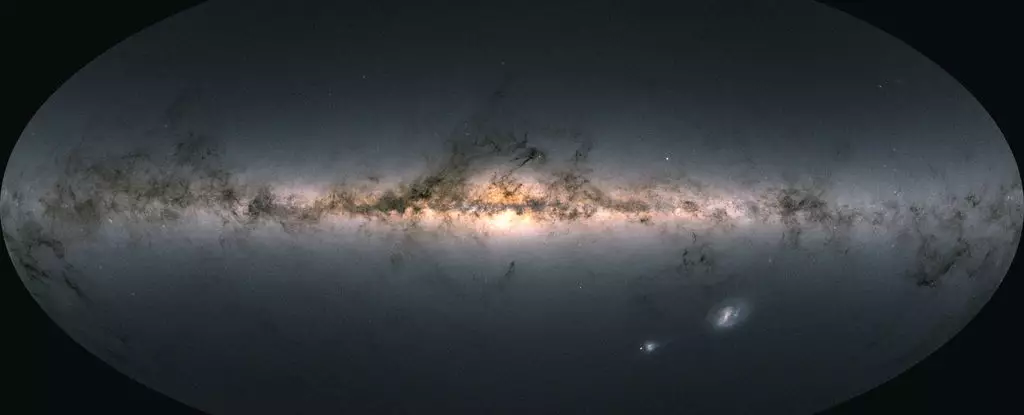The cosmos is a vast expanse filled with mysteries, and among them, the existence of black holes stands as one of the most profound enigmas that contemporary astrophysics seeks to unravel. Recent discoveries suggest that a supermassive black hole, potentially residing in the Large Magellanic Cloud (LMC)—a dwarf galaxy in orbit around the Milky Way—might play a pivotal role in our understanding of gravitational giants. New findings indicate a massive, unseen object weighing approximately 600,000 times that of our Sun, posing intriguing questions about the evolution of black holes as they grow from stellar sizes to colossal formations housing millions, if not billions, of solar masses.
Identifying black holes is a notorious challenge, primarily due to their nature of existing in silence; they emit no detectable radiation unless they indulge in feasting on nearby matter. This characteristic often compels astronomers to adopt innovative methodologies to uncover these elusive entities. In this case, researchers, led by astrophysicist Jiwon Jesse Han from the Harvard & Smithsonian Center for Astrophysics, utilized a distinct approach. Instead of focusing on the typical orbital motion of stars—which aided in confirming Sagittarius A*, the supermassive black hole at our Milky Way’s center—they examined hypervelocity stars.
Hypervelocity stars are exceptional in that they travel at speeds much higher than normal stars, setting them on potential trajectories leading them far beyond the confines of their galactic homes. The study centered on 21 such stars found in the Milky Way’s outer halo, using data from the now-retired Gaia space telescope, which provided three-dimensional mappings of the stellar environment within our galaxy. This innovative approach demonstrated that these hypervelocity stars possibly originated from interactions with a hidden black hole, aligning well with a theory known as the Hills mechanism.
The Hills mechanism describes a fascinating gravitational dance involving three celestial bodies: a black hole and two stars. Through complex interactions and exchanges of momentum, this dance can lead to one of the stars being expelled at high speed into the depths of space—essentially ‘yeeted’ out into the cosmos. The research team meticulously traced the movements of these hypervelocity stars, ruling out alternative acceleration scenarios, to establish credible links to a supermassive black hole within the LMC.
Among the 21 stars analyzed, 16 were successfully traced back to their points of origin. Seven were found to be sourced close to Sagittarius A*, while the remaining nine exhibited characteristics indicating ejections from the Large Magellanic Cloud, providing strong evidence for the proposed hidden black hole. This binary interaction between the LMC and the Milky Way thus emphasizes a cosmic interplay that could unveil the growth mechanisms of black holes.
Collision Course: The Future Merge of Galaxies
The Large Magellanic Cloud is currently situated approximately 160,000 light-years from the Milky Way, but it is on a slow trajectory towards our galaxy. Predictions suggest that in about 2 billion years, a merger will occur—a cosmic event that could rekindle interest in the dynamics of cosmic evolution and the life cycle of black holes. The merging of these two galaxies, along with the potential amalgamation of their respective supermassive black holes, represents a pivotal moment in galactic evolution.
As the LMC approaches, observers in the future may have the opportunity to witness the enlargement of black holes as they assimilate stellar material and integrate with their galactic counterparts. This gradual increase in mass could ultimately lead to the formation of a new supermassive black hole at the heart of the Milky Way, further fueling our understanding of black hole formation, growth processes, and their crucial role in galaxy dynamics.
As researchers work towards confirming the existence of the 600,000 solar mass black hole in the Large Magellanic Cloud, the excitement surrounding black hole research continues to mount. The findings offer more than just a glimpse into the hidden forces shaping our universe; they pose broader questions about the lifecycle of galaxies and the cosmic machinery that powers them. It’s a thrilling time for astrophysics, where past hypotheses gain substantial support and ignite new curiosity about the fundamental workings of our cosmos. Future research will be essential in affirming this discovery and shedding light on the dynamic relationship between black holes and galaxy evolution, continuing humanity’s quest to decipher the mysteries of the universe long after we have faded from existence.

